
Wednesday’s ad is for the Scottish lager Tennent’s. Given the bottle, I’m guessing this is an old ad, maybe late 19th century. With the two dogs, the tagline “Give us your business & we’ll hold it” is pretty funny.

By Jay Brooks

Wednesday’s ad is for the Scottish lager Tennent’s. Given the bottle, I’m guessing this is an old ad, maybe late 19th century. With the two dogs, the tagline “Give us your business & we’ll hold it” is pretty funny.

By Jay Brooks

This is a great example of what I hate about anti-alcohol organizations and the Marin Institute in particular. Given that they’re trying to impose a new tax on alcohol in San Francisco using a mechanism that came about through case law (the Sinclair decision) where calling what would otherwise be a tax a “fee” allows them to circumvent the normal two-thirds vote needed for a new tax, it’s no surprise that they’re against one of the propositions on the November ballot — namely Prop 26. That’s because Prop 26 seeks to do away with the Sinclair loophole where taxes masquerading as a fee will no longer require a simple majority, but will instead need two-thirds to pass, just like every other tax. That would be a big blow to their efforts to get more taxes imposed in other communities in California. So it’s entirely natural that they’d oppose it. I’d have been surprised to hear any other scenario.
But here’s what I didn’t, but perhaps should have, expected: the low down dirty politics and propaganda by which their opposition has taken shape. In an e-mail blast today, the Marin Institute is blaming “big alcohol” for the proposition and acting as if it’s happening in a vacuum, with no responsibility on their part. It’s shameless spin and as ugly a piece of propaganda as I’ve seen. If I’d had a beer in mouth when I was reading it, I most likely would have spit it out in surprise on more than one occasion.
First of all, they characterize the proposition as one which would “essentially absolve companies that pollute, or otherwise cause harm to the public, from paying for that harm by subjecting fees to the same impossible two-thirds vote that taxes must garner to be enacted.” Horseshit. What the proposition does is subject all taxes to the same standard, in effect closing the loophole that Sinclair opened. Calling them “fees” to get around the 2/3 standard was simply a way to circumvent the state tax law.
A stated by the Yes on 26 advocates:
State and local politicians have been using a loophole in the law to raise taxes by disguising them as “fees” — costing consumers billions of dollars in higher costs for goods like food, gas, and cell phones. Prop. 26 requires politicians to meet the same Constitutional requirement to pass these Hidden Taxes as to pass other taxes — with a two-thirds vote of the Legislature at the state level, and with a vote of the people at the local level.
Next the Marin Institutes note “a review of the Yes on Prop 26 website shows Big Alcohol’s fingerprints all over the measure.” By “all over,” of course, they mean are supporting it and/or have donated money to support it. They go on to add that “August saw an infusion of $800,000 to the Prop 26 campaign by the Small Business Action Committee (SBA). According to an article in Capitol Weekly, the SBA “revealed that it received more than $1 million from alcohol, tobacco and real estate groups. Altria, the parent company of Philip Morris USA, donated $500,000. Anheuser-Busch, which brews Budweiser, gave $200,000 and the Wine Institute chipped in another $50,000.”
Hmm, in August there was infusion of donations to support Prop 26? What might have triggered that? What is the Marin Institute not telling you? July and August is when every company who makes alcohol, distributes alcohol and sells and serves alcohol realized they were under attack by the Marin Institute, who was pushing Avalos and supplying him him with all the resources for the test case to add a new tax to alcohol in San Francisco. That’s when most us even became aware of Prop 26. Before that, I’d wager, hardly anyone in the alcohol industry had paid it much attention. When you’re being attacked, you tend to defend yourself.
But the Marin Institute also makes it sound as if “Big Alcohol” and “Big Oil” are behind Prop 26. They’re not. The proposition was sponsored by the California Chamber of Commerce and the California Taxpayers’ Association, not exactly radical organizations out to cheat the public the way the Marin Institute spins it. While the Marin Institute focuses on beer and wine companies, there are over 100 organizations who support the proposition, including nearly sixty chambers of commerce and tax organizations. The rest are primarily trade organizations from a wide range of businesses and industries. That alcohol companies seem over-represented is a direct result of the actions of the Marin Institute. So having caused this situation, using it in propaganda against the proposition without acknowledging it seems pretty shiftless to me.
But it’s their conclusion that has me sighing in exhausted frustration. “Instead of spending all that money to get out of paying for the harm its products cause, perhaps Big Alcohol could instead just pay its fair share to offset massive societal costs.” I’m so tired of this mantra of theirs. First of all, the harm isn’t caused by the products — alcohol — but by individual abusers, people who should take responsibility for their actions. And the vast majority of drinkers do not abuse it. Second, every good or service sold in the world has the potential to cost society something, and most in fact do. But the idea that only alcohol has to “pay” the costs that abusers cost society is maddening. Guns, red meat, high fructose corn syrup, oil, cars, fast food, and every freaking other thing gets a pass; economists even have a word for it — externalities. But the insistence that alcohol has to pay for the bad decisions by individual abusers just rankles, especially when that’s characterized as its “fair share.” Either everything — every company, every product, etc. — pays the individual costs to society that can somehow be ascribed to them or no one does. There’s nothing fair about making one pay while everyone else gets a pass.
By Jay Brooks

This weekend, September 11 & 12, the 7th annual Brews on the Bay beer festival will take place aboard the S.S. Jeremiah O’Brien anchored off Fisherman’s Wharf in San Francisco. It’s put on by the San Francisco Brewers Guild. Tickets are $45 in advance, and may be purchased online. At the door, tickets are $55. See you there.
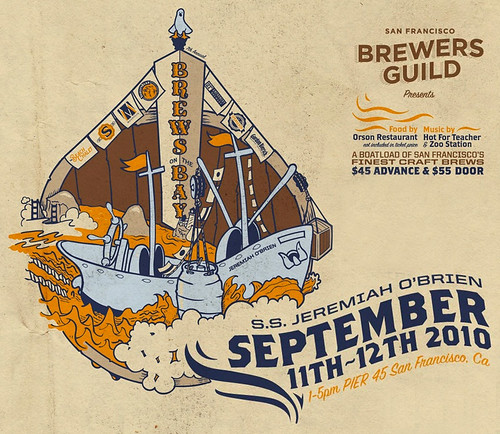
By Jay Brooks
![]()
British beer writer Phil Mellows, who also specializes in alcohol policy, had an interesting observation in a recent post, Alcohol Consumption Down, Alcohol Harm Up. In his native England, as is happening here, overall alcohol consumption has been on a slow but steady decline for a number of years. The problems associated with alcohol abuse, however, have not. Yet the policies here and there are based on the anti-alcohol organizations and “the medical profession who say that to reduce alcohol harm we have to reduce overall consumption, [which is] the logic behind raising the price of alcohol and restricting its availability.” That’s also one of the reasons that these same people keep trying to impose more and more taxes on alcohol. Yet it’s not working. It’s never worked. Phil concludes by trying to make sense of it.
Rather than trying to get the whole population to drink less (which they are, in any case, already doing), alcohol policy should be focused on the growing minority of people, more stressed even than [the prime minister], who are quietly drinking themselves to death out of despair.
And that’s been the problem with alcohol policy here, too. They keep trying to punish the industry and the majority of people who drink it responsibly in order to stop the problem drinkers. It doesn’t work. It’s never worked. It ignores the underlying causes of alcohol abuse. The people who don’t abuse it and in fact enjoy it in moderation — which is a healthy choice — are the ones who pay the price. It’s frustrating. It’s ineffective. It ignores the real problems and punishes the innocent, not to mention it may damage one of the few healthy industries in the economy. But it keeps on happening. Someone has to say enough. I’m happy to start. Enough, already.
By Jay Brooks

Tuesday’s ad is for the Mexican beer Tecate, brewed by Cuauhtémoc Moctezuma Brewery. The brewery was founded in 1890. I have no idea when the ad is from, though it has a look of the 1950s or early 60s. Norman Rockwell south of the border.

By Jay Brooks
![]()
Our 44th Session will be hosted by Ashley Routson a.k.a. The Beer Wench. In honor of Halloween month, she’s chosen “Frankenstein Beers” as her topic, which Ashley likens to Frankenstein’s monster, a creation that was “constructed of human parts and various other inanimate objects,” defying nature’s laws and ultimately “unlike anything the world had ever seen before.” She continues.
Many craft brewers are like Frankenstein. They have become mad scientists obsessed with defying the laws of brewing and creating beers that transcend style guidelines. These “Frankenstein Beers” challenge the way people perceive beer. They are freaks of nature — big, bold and intense. The ingredients resemble those of a beer and the brewing process might appear to be normal, but some aspects of the entire experience are experimental, unorthodox and insane.
An altercation with these beers produces confusion in the eye of the taster … is it a beer, or a monster?
“I do know that for the sympathy of one living being, I would make peace with all. I have love in me the likes of which you can scarcely imagine and rage the likes of which you would not believe. If I cannot satisfy the one, I will indulge the other.” — The Monster.
Your mission, should you choose to accept it, is to write a blog post on “Frankenstein Beers.” There are no rules about how to write about this topic — feel free to highlight a Frankenstien brewer, brewery, beer tasting notes … or just your opinions on the concept.
So don’t be afraid, pull out the surgical tools and make a trip to the cemetery (or bar) for parts — just don’t grab the jar marked — “abnormal” — for your own post for the next Session, on Friday, October 1.
By Jay Brooks

For the second time, San Francisco supervisor John Avalos has gone back on his word. As the sponsor of the the new proposed tax on all alcohol sold in San Francisco ordinance, he first told the Small Business Commission that he would delay a hearing on the tax in mid-July. But because of Proposition 26 on the ballet having the potential to do away with the type of tax masquerading as a fee that he’s proposing, he changed his mind and went forward with the hearing anyway. Later, in late August, it looked like it was all but inevitable that he would send it back into committee for more review due to overwhelming opposition by the business community. Well that didn’t last long either, and he changed his mind again and later today, at 2:00 p.m., the San Francisco Board of Supervisors will vote on the new tax. It’s likely that it will get the required six votes to pass and at that point will be voted on a second time at another board meeting on September 14.
It will then go to mayor Gavin Newsom, who has ten days to either sign or veto it. The mayor is on the record saying he’ll veto it, at which point it will be sent back to the Board of Supervisors who can override Newsom’s veto with eight votes. That would most likely be in early October. Why Avalos keeps saying one thing and doing another is pure politics, of course. The strategy now is that “he wants to push for a veto override.” The likeliest reason is that someone — perhaps the Marin institute? — has whispered in his ear that they can flip two supervisors and get him the two additional votes he needs to override the anticipated mayoral veto. The Marin Institute has begun marshaling their base to contact the politicians against the alcohol tax in a web alert. Obviously, that works both ways and I’d suggest that if you’re against the new tax, you should contact them and ask them to continue to oppose it.
If you’re in the city today and want to oppose this tax, please consider attending the meeting and voicing your opposition. I’ll have more on this later on today, but wanted to get this out as soon as possible.
UPDATE: Today’s vote has been canceled due to some sort of mix-up with the clerks office. It has now been rescheduled for next Tuesday, September 14.
By Jay Brooks

Monday’s ad is from a French brewery in the medieval village of Albi, the capital of Tarn, a tourist area in southern France. Founded in 1822, I assume that’s King Gambrinus holding the bottle with his picture on it. I also imagine those are supposed to be hops in the foreground, but they look more like strawberries.
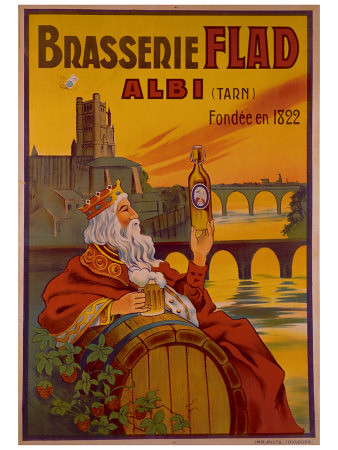
By Jay Brooks

In honor of labor day, here’s a fun series of illustrations showing all the labor necessary to make beer, in this case Guinness. In 1981, Guinness commissioned British illustrator and artist John Ireland to create twelve paintings whimsically depicting the steps that go into making Guinness beer for a calendar.
From the Guinness Collector’s Club website:
John was born on the 19th March 1949 at Aldershot Hants and attended Farnham Grammar school, Farnham Art School and finally Ravensbourne College of Art and Design. He lived and worked in London from 1971 until moving to Norfolk in 1976. John has two sons, two sheep, a dog and a wife Tessa and has worked as a freelance illustrator since leaving college, principally for magazines and publishing, with a little bit of advertising. In recent years. A lot of his work has involved caricatures including collections of sporting personalities and a weekly drawing for the TV Times for over nine years.
John [Ireland] writes:
“I had been asked a few years prior to 1980 to submit ideas for a Guinness Calendar but nothing came of it, and when I was asked to produce roughs for a W. Heath Robinson pastiche I was initially reluctant, suggesting I could do something in my own style. When it became obvious that they – J.Walter Thompson the advertising agency — were set on doing it their way, I decided that it was better I should do it rather than someone else mess it up and do Heath Robinson a disservice.”
“There were similarities in our styles, which is presumably why I had been asked in the first place. I had been interested in his drawings since I was a child, having bought his books at jumble sales. The whole job went amazingly smoothly and following a guided tour of the Park Royal Brewery, it was left up to me to decide on which elements of production I should highlight.”
“This is so unusual for advertising, normally you are presented with layouts that you have to stick to rigidly and all the copy has been written already. In this instance I even wrote the captions. My initial roughs were accepted with hardly any changes suggested. I only had to make the May drawing a little busier and ensure that wherever possible both bottled and keg beer should be depicted as apparently there was intense rivalry between the two divisions of the company. The barman in the December drawing is actually a portrait of Heath Robinson with his cat ‘Saturday Morning’ and the customer is my Father.”
Blogger Phil Beard, at his Notes on the Visual Arts and Popular Culture, also has a nice post on the series. These days John Ireland is best known for his caricatures.
January: Hop Picking Time in the Guinness Fields

February: Early Morning on the Guinness Farm

March: Industry in the Guinness Maltings

April: Roasting the Guinness Barley

May: Mixing the Guinness Mash
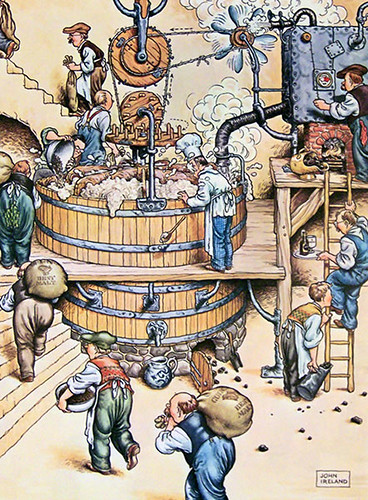
June: Filtering the Guinness Wort

July: Fermenting the Guinness
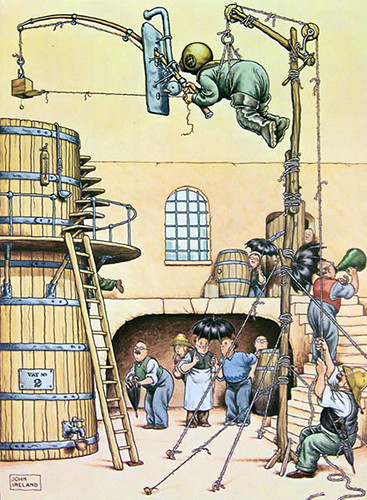
August: Bottling the Guinness
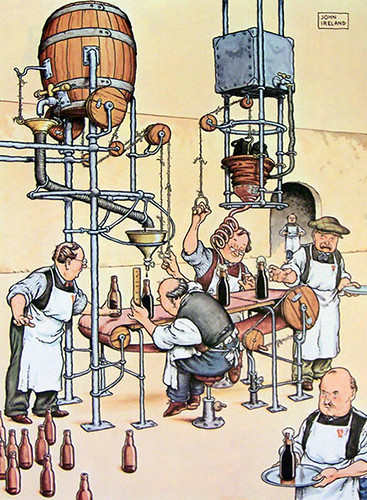
September: Signing the Day’s Production of Guinness
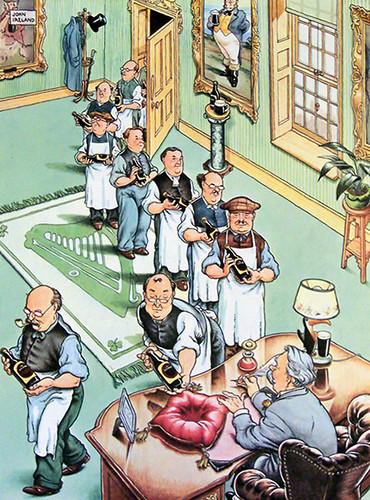
October: The Training of the Guinness Quality Testers
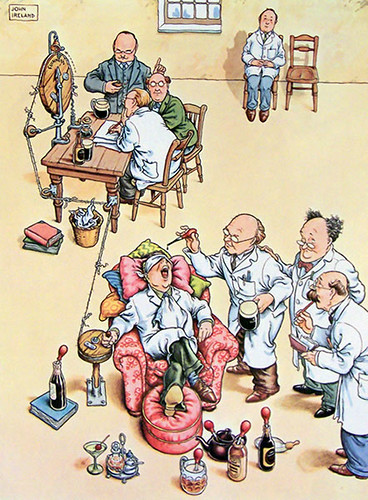
November: Delivering the Guinness
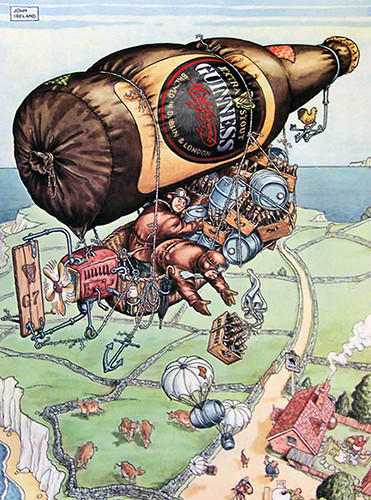
December: The First Guinness of the Day
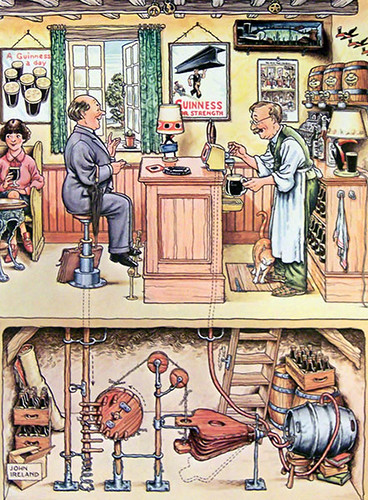
By Jay Brooks
![]()
Yesterday, we took our annual family-outing to pick hops at Moonlight Brewery in Sonoma County, California. Founder and brewmaster Brian Hunt has a quarter-acre he planted several years ago after Vinnie Cilurzo, from Russian River Brewing, had to pull out the hops he had at Korbel when he moved the brewery to Santa Rosa. Russian River’s now growing their own and Moonlight has continued to keep his hopfield going, using the hops primarily to brew his fresh hop beer Homegrown.
I’ve been volunteering to help pick hops for a number of years now, and began taking the family a few years ago, recreating how it would have been done in he later Nineteenth century before hops were harvested using machinery. In those days, the entire community would turn out to pick the hops, with the men working the fields, women putting on lavish picnic spreads (and helping with the picking) and the kids pitching in andalso playing among the hopvines. It’s great fun and really does feel like the community coming together to help out. Everyone does their part, and we all talk and laugh while sitting in the circle and picking the hops.

The Abbey de St. Humulus hop field, a.k.a. Moonlight Brewery
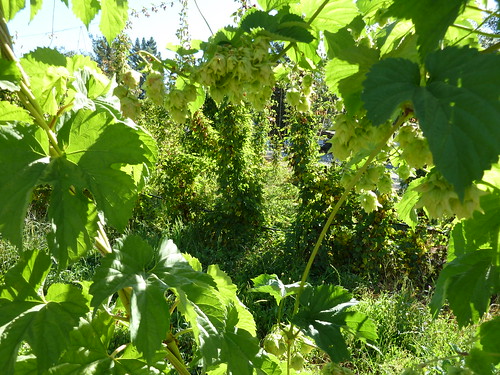
The beautiful green of hops in the field, ripe for the picking.
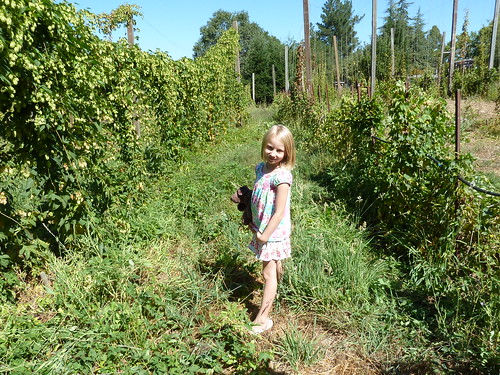
My daughter Alice outstanding in her field … hop field, that is.

Hops on the vine, as far as the eye can see.
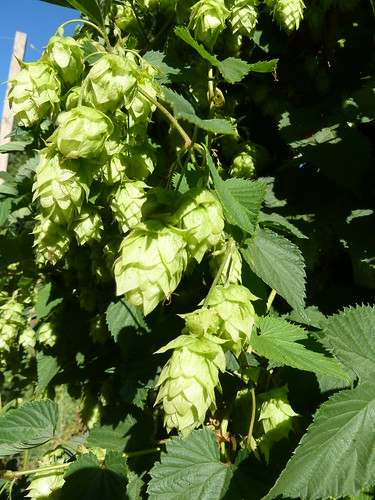
A close-up of the hop cones, the flowers that will be picked and added to the beer.
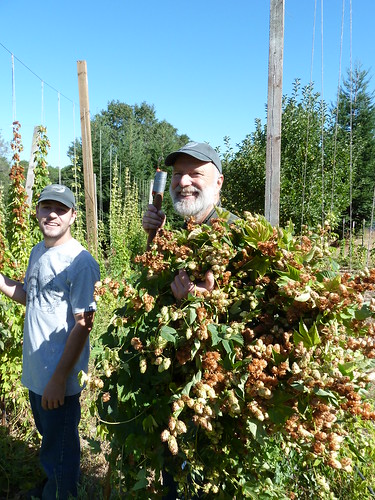
Moonlight brewmaster Brian Hunt holding a bundle of hops, freshly cut down for picking.
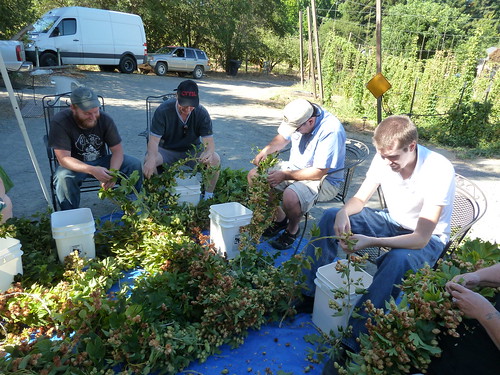
The hopvines are placed in the center of a circle, where people work on each vine, pulling the hops off by hand and putting them into a plastic bucket.

My wife Sarah showing off her hop-picking skills.
Below is a slideshow of our family outing to pick hops. This Flickr gallery is best viewed in full screen. To view it that way, after clicking on the arrow in the center to start the slideshow, click on the button on the bottom right with the four arrows pointing outward on it, to see the photos in glorious full screen. Once in full screen slideshow mode, click on “Show Info” to identify each photo.
And below is a short video of cutting down the hops and taking them to be picked.
